Table of Contents
Getting buy-in (and budget) to implement a high-quality content marketing strategy is hard, especially because content marketing is misunderstood in many organizations. Maybe you’ve been burned before by hiring a content farm that churns out low quality, high volume content. Or perhaps you trusted an agency that said “results take time”…never to see those results come to fruition.
To keep this from happening, it’s important to set — and clearly communicate — content marketing goals.
Will goals always be tied directly to the bottom line? No. But they should be connected to the company’s larger branding and marketing efforts, and they shouldn’t be vanity metrics.
Content marketing can, and should, be measured in a meaningful way. These content marketing goals will help you communicate the value of your efforts beyond just total link and traffic numbers.
Content Marketing Goals for Your Business
Different types of content will achieve different goals. Consider where each piece of content falls in the buyer journey and use that information to establish goals for each content type.
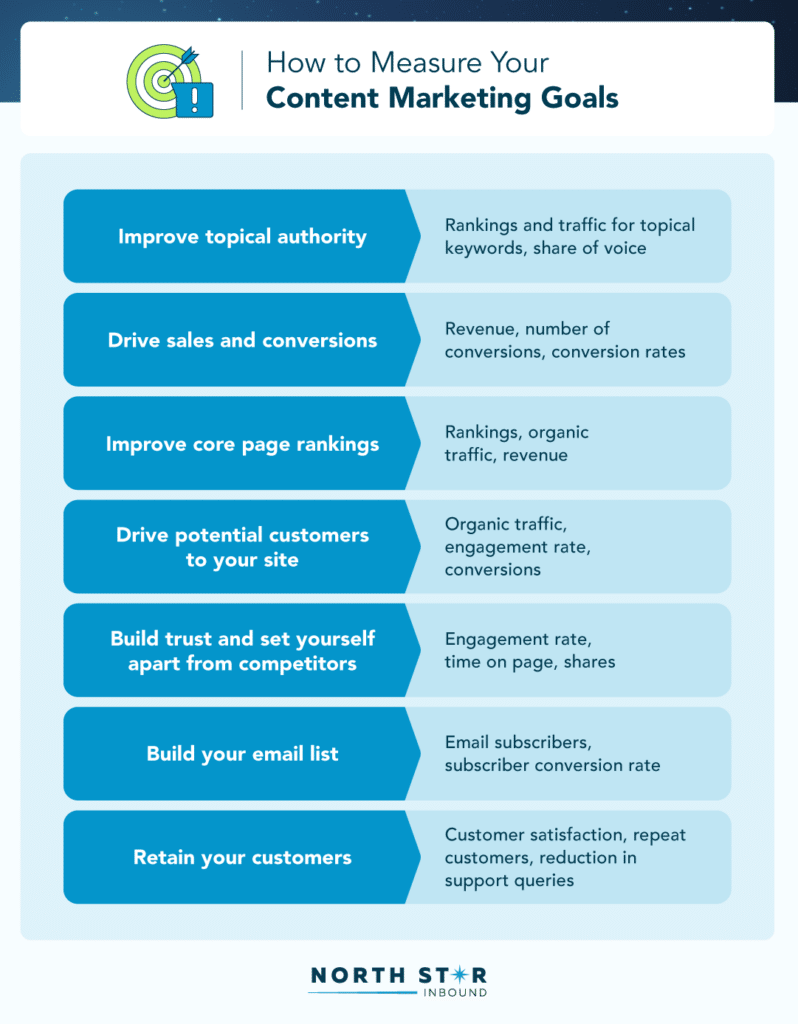
1. Improve Your Site’s Topical Authority
Topical authority is the measure of your site’s expertise on a topic. The more authoritative that you are on a certain topic, the better your content about that topic will rank (assuming that the content is truly helpful).
You don’t want your content to be so varied that your site feels like a jack of all trades and a master of none. After all, how much would you trust someone’s expertise if they knew a little bit about a lot of things? Not a lot. Google feels the same way.
By setting a content marketing goal of building topical authority, you’ll consciously focus your content strategy on topics related to your company’s niche.
A common way to do this is with the hub and spoke model, in which you identify broad topics (hubs) and more detailed supporting topics (spokes) that are related to your business. By fully fleshing out a hub and all related topics, you are building topical authority.
For example, Tactics, a snow and skate gear company, creates detailed buying guides. Their guide on how to choose a snowboard links out to related articles like:
- Snowboard size chart
- Camber snowboards
- Snowboard shapes
- Types of snowboard bindings
Tactics has used this strategy to build its topical authority, gaining visibility next to high-authority competitors like REI and Evo.
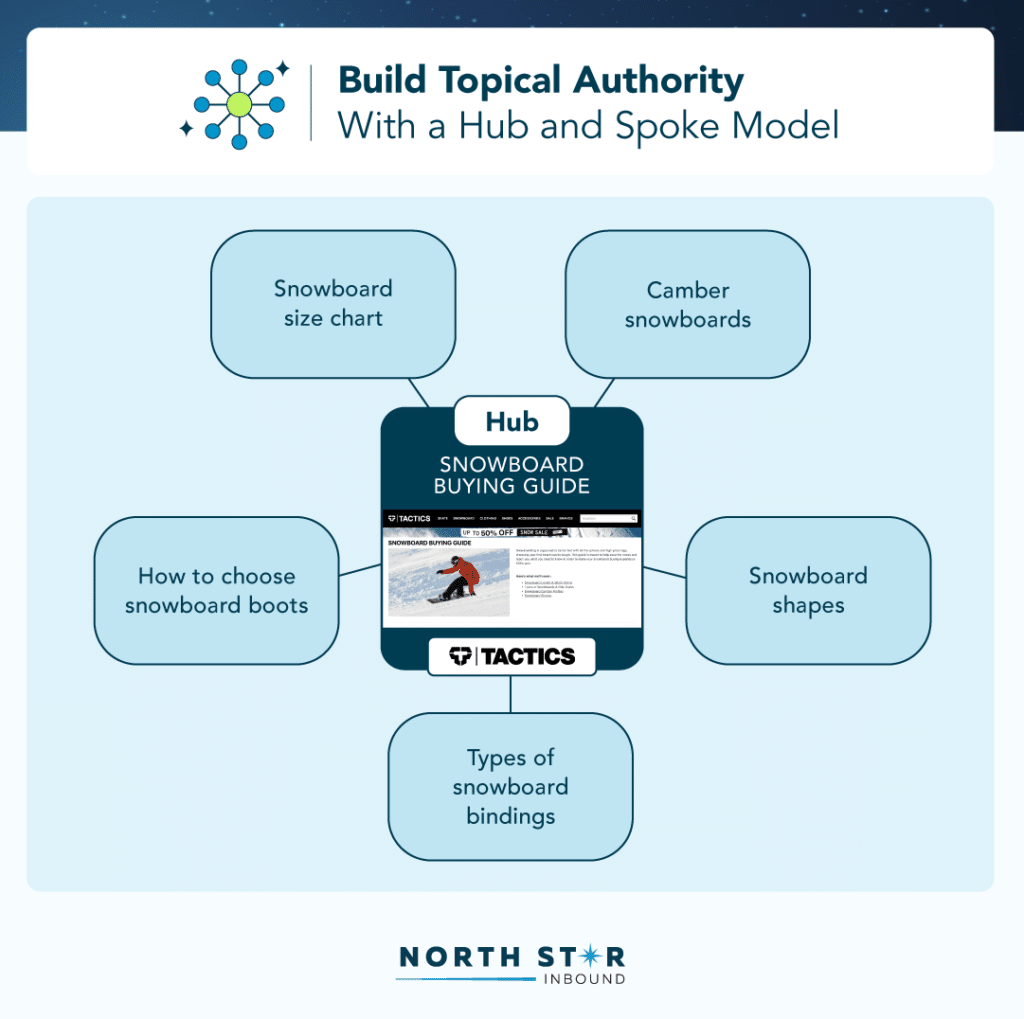
2. Drive Sales & Conversions
This is the ultimate content marketing goal. However, it’s important to understand that sales and conversions are an unrealistic content marketing goal for all content.
Users who will convert are typically at the decision making stage.
To identify content that will convert, ask yourself: What decision is the user making and how is your piece of content helping them make it?
For example, we have a snap-on veneers client. We know that someone who wants an affordable cosmetic dental option will weigh the pros and cons of different removable veneers before purchasing.
To capture the searcher at this stage of their decision making process, we created a Best Snap-on Veneers post. Our client is one of the most affordable brands and has the longest standard warranty, so they stand out amongst competitors. The result? Thousands per month in revenue from this post alone!
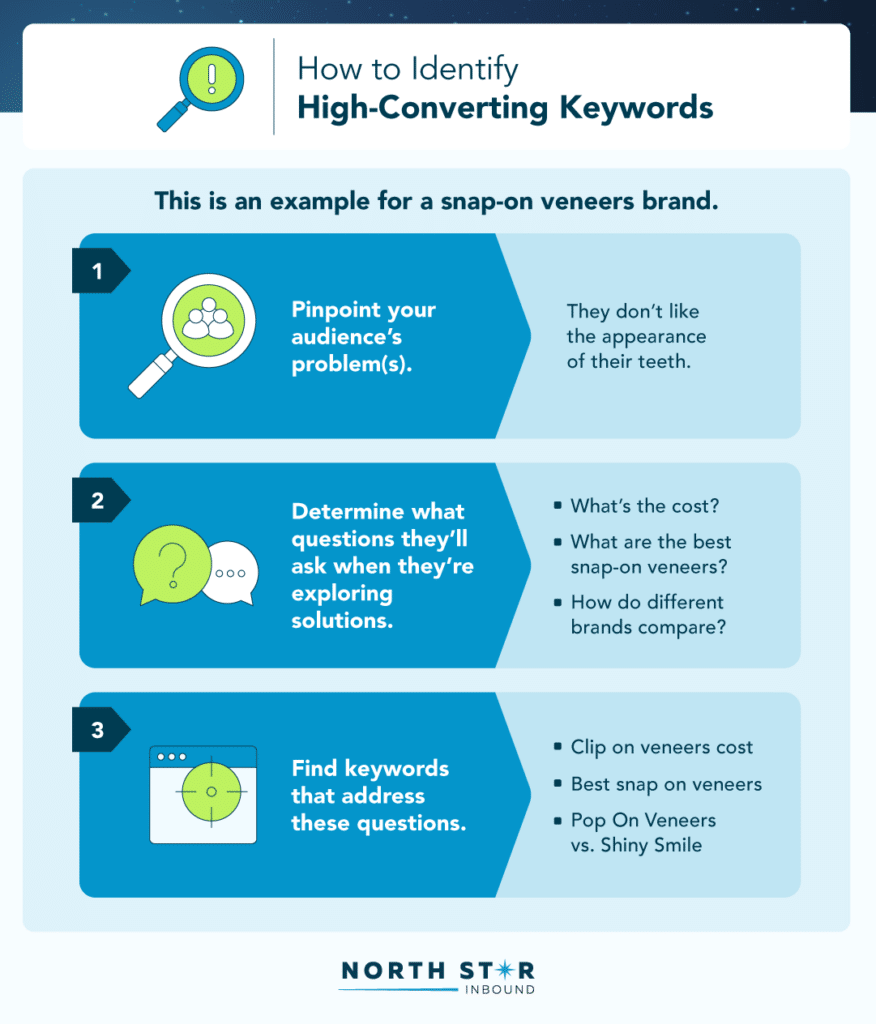
Depending on your business model, your goal might be for the searcher to request a quote or sign up for a demo. The content strategy is still the same — understand the searcher’s pain point and how you can help fix it. Then, create content that captures them as they’re making a decision.
Topics with conversion potential should be the highest priority in your content strategy because they can impact the bottom line and prove content marketing’s value.
3. Improve Core Page Rankings
While a common content marketing goal is to earn a certain number of links, we make a point to report on the bigger picture too. Links should improve a site’s domain authority and pass link equity to core pages, boosting their rankings and traffic.
If you’re just building links to hit a quota, you’re focusing on the wrong goal.
At the beginning of each engagement, we identify how a client’s core pages are ranking and which can use a boost. Then, we prioritize passing link equity to these pages through strategic internal links from link earning campaigns.
Guess what? It works. We’ve helped multiple sites rank #1 for their core keywords and in turn see a boost in sales or ad revenue.
For example, we were able to help this online gaming client, who is monetized by ads, go from #9 to #1 for their most important keyword and related keywords, resulting in a massive boost in traffic and revenue.
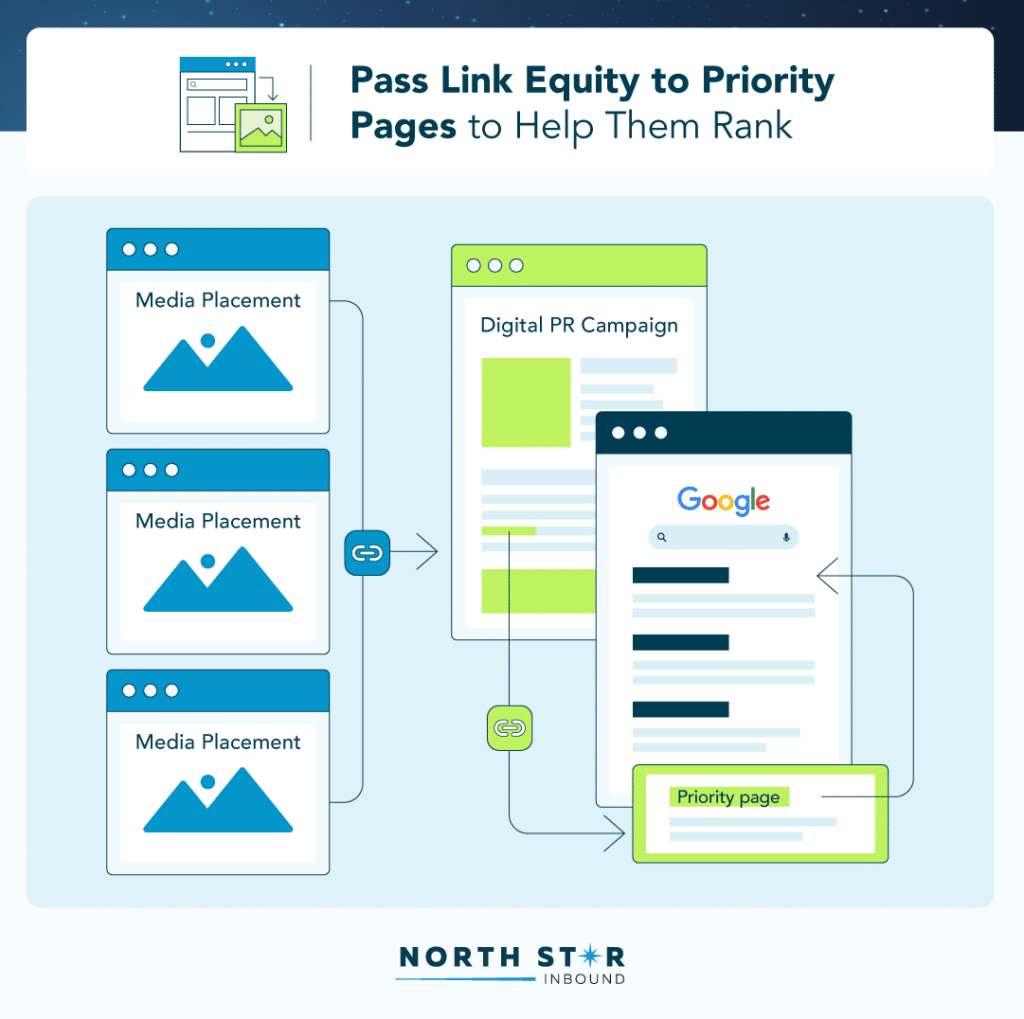
4. Increase Traffic, Driving Potential Customers to Your Site
Content marketing has the potential to get your brand in front of the right people and leave a lasting impression.
The tricky thing is that not all traffic is valuable traffic — some topics may drive views from people who would never be interested in your product or service. As you put together your content strategy, really hone in on your customer personas and what they would be searching for at the top, middle, and bottom of the funnel.
Your focus needs to be on targeting the right audience, not reaching a ton of people who couldn’t care less about your product or service.
For example, StyleSeat is a platform where clients can find beauty professionals and book their services. While they could rank for a topic like “claw clip hairstyles,” someone searching for that term is styling their hair at home.
It makes more sense to expend effort on topics that more closely related to services like:
- Haircut prices: The searcher needs a haircut and is trying to understand how much it should cost and what competitive rates are.
- Partial vs. full balayage: The searcher is interested in balayage and trying to understand the different options and if it would look good on their hair.
- Highlights for gray hair: The searcher is looking for inspiration to see different ways highlights can hide or accentuate gray hair before they go to a stylist.
We like to prioritize middle and bottom of funnel content first, and then weave in top of funnel content. This ensures that we’re creating the most relevant content for your target audience. You can then retarget this audience on social media to increase your visibility.
To make sure your content stays focused on the right audience, you may want to list each piece’s goal in your planning document. If the goal doesn’t clearly map back to your product, service, or brand initiatives, the content probably isn’t a good fit.
5. Build Trust & Set Yourself Apart From Competitors
Your content could be a potential customer’s first impression of your brand. If it’s not impressive, you’ll lose their trust. If it’s helpful and unique, they’ll remember you in the future and may even revisit the site.
Think of a piece of content that you saved, shared, or referred back to over and over again. Every content marketing effort should leave that type of positive impression. Each piece of content should clearly and quickly solve the users’ problem.
There are multiple ways you can do this.
For example, King Arthur Baking provides a general answer to the query “what temperature is bread done baking,” and then details the best temperature for different types of breads based on their testing. The results photos show their expertise and experience, garnering trust from the reader. This is an approach that no other competitor has executed well.
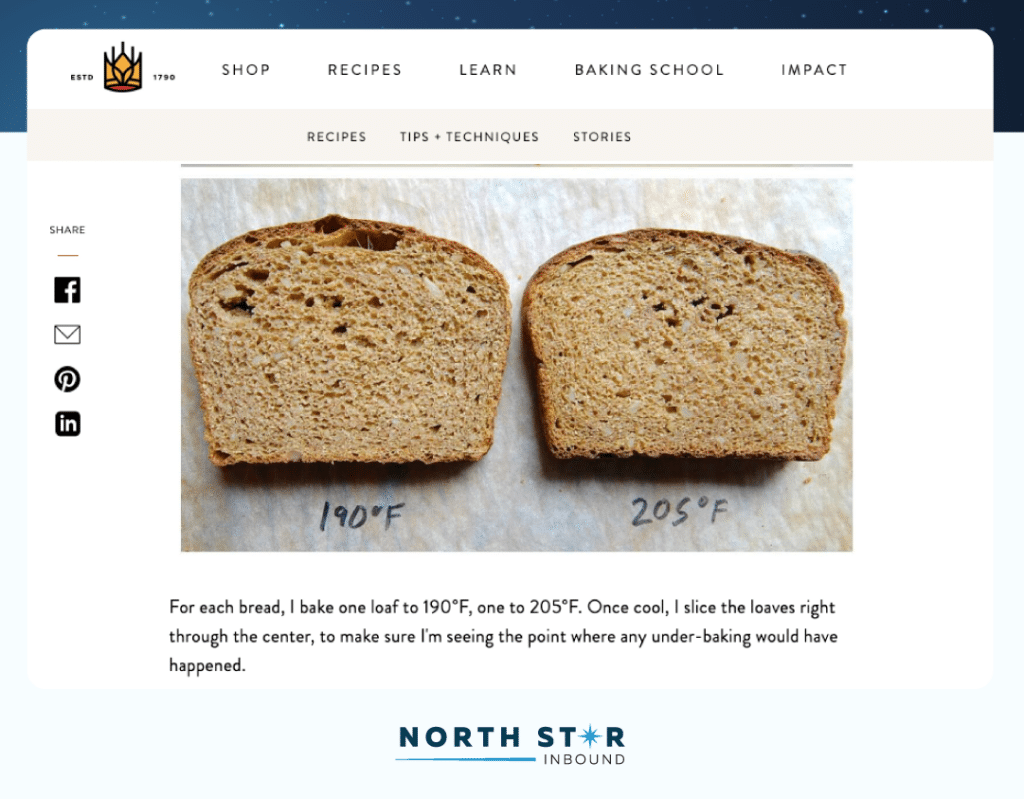
Another way to set yourself apart is through good UX and ease of use. Canva does this with their free tools and templates. For example, their budget templates page has countless free templates for different scenarios and aesthetics.
The searcher can quickly easily find, edit, and customize a template that fits their needs without sifting through lengthy explanations or landing on a page that only has one or two template options.
6. Build Your Email List
Your content marketing efforts have captured an audience and gained their trust. That shouldn’t all be in vain. Adding CTAs for email capture will help you continue to nurture potential customers, which could eventually lead to sales.
One strategy to build your email list is through gated content — create a high-quality case study, e-book, report, template, or tutorial that is “gated,” prompting users to share their content information to gain access. It’s a win-win.
Hubspot does a great job of this, offering a relevant gated download right under the title and again throughout the article.
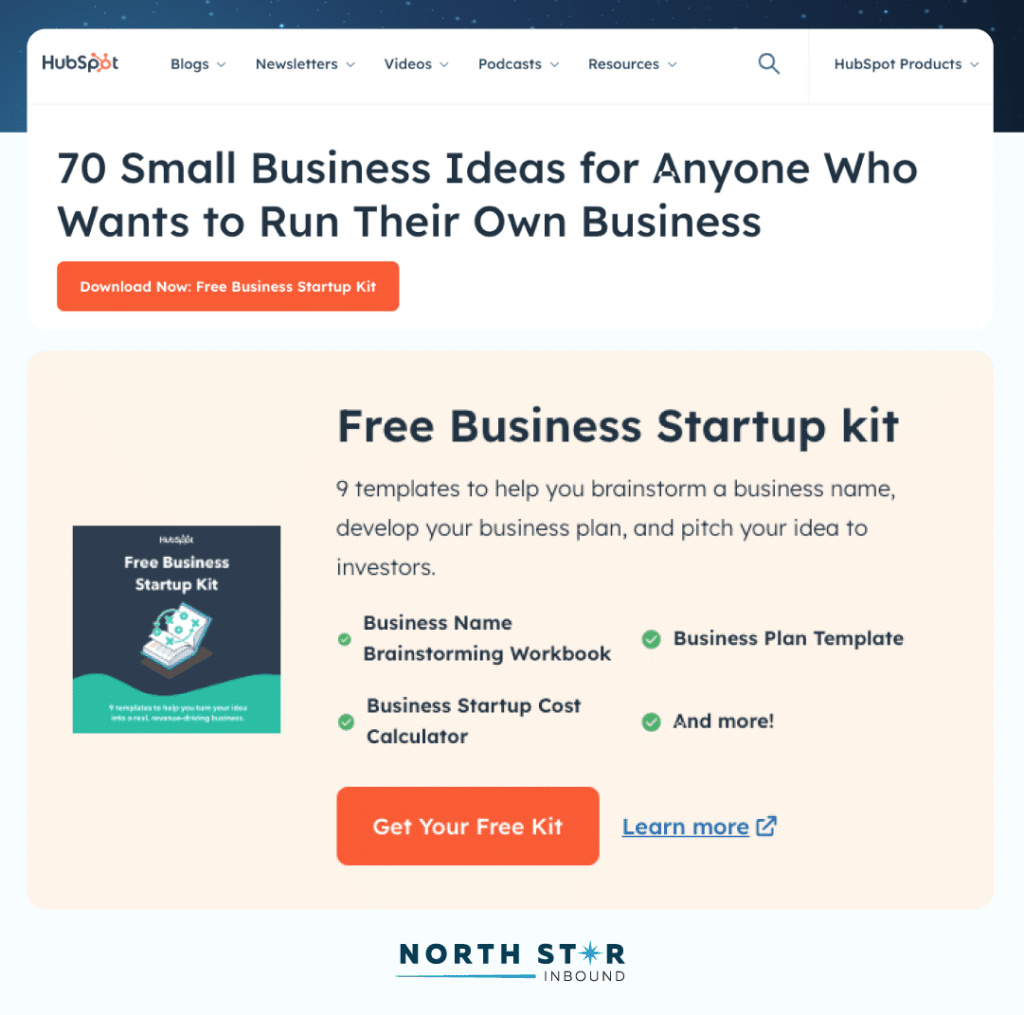
Gated content isn’t the only way for your content to prompt email signups, though.
Strategically placing newsletter CTAs on a page can increase sign ups. These could include:
- A timed email pop-up
- Inline CTAs
- Sticky sidebar form
- Header or footer subscription opt-ins
Once you’ve captured their email, nurture your subscribers. Continue to educate them on your product or service, offer them special deals, and keep your brand top of mind.
7. Retain Your Customers
Content marketing can help customers thoroughly understand how to use your product or service, improving customer satisfaction and reducing your customer service reps’ workload.
A dedicated Support or Tutorial section makes important resources easier to navigate to, allowing your customers to educate themselves or troubleshoot issues.
Imagine unboxing an espresso machine with a thick manual and multiple pieces. You’re immediately overwhelmed and instead of following pages and pages of directions you Google, “how to set up my Breville.”
You’re presented with a short, easy to follow video and related tutorials. Soon, you have a steaming cup of espresso in your hands and a brand affinity that will blossom into brand loyalty as you continue to use the machine and tutorials.
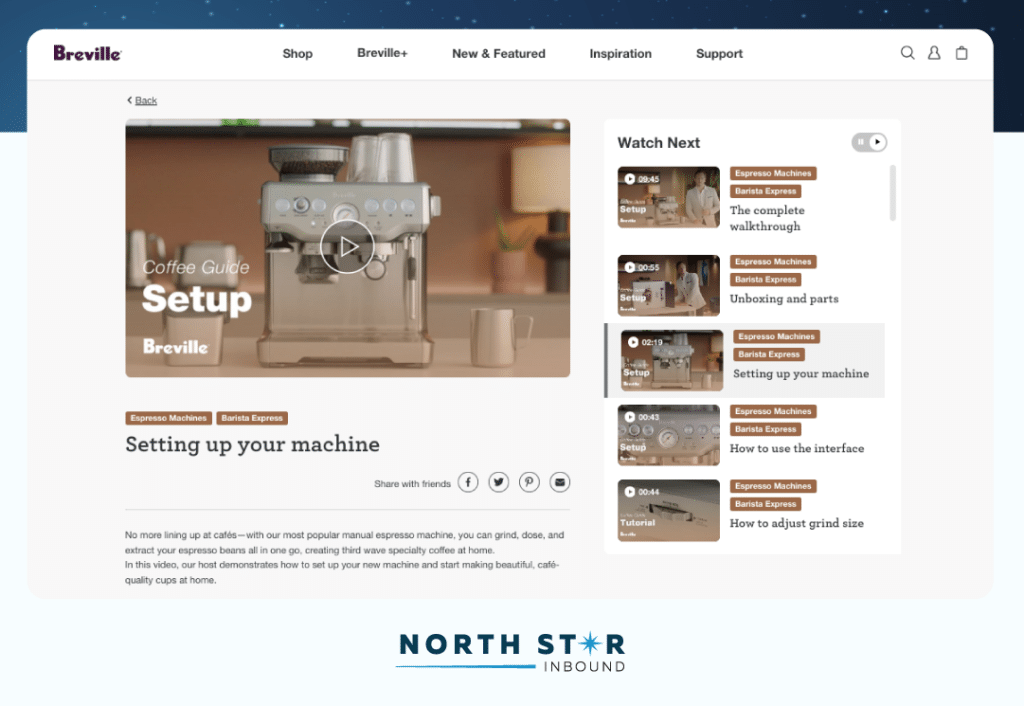
This content provides the customer with ease of use, reducing frustration or friction that they could experience at various touch points.
How to Choose and Track Your Content Marketing Goals
Your content marketing goals will vary depending on what your website has already achieved, the authoritativeness of your site, and the types of resources you have available.
Take the time to consider your business goals and the types of people you want to attract and retain. Then, map each of your content marketing goals back to those things.
Here are some general guidelines for when to set each goal and how to track success.
| Goal | When to set it | How to achieve it | What to track |
|---|---|---|---|
| Improve your site’s topical authority | Your site needs to establish its expertise in a specific area | Create content in a hub and spoke model | Rankings and traffic for topical keywords, share of voice |
| Drive sales and conversions | You have a clear understanding of your customer and the sales funnel. | Provide solutions and answers to questions your customer is asking. Avoid relying solely on search volume to identify these opportunities. | Number of conversions, conversion rates, revenue |
| Improve core page rankings | Your site authority is on par with competitors and your core pages are well optimized. | Add internal links from highly linked to pages to core pages. | Rankings, organic traffic, revenue |
| Increase traffic, driving potential customers to your site | You have the resources to create helpful, well-optimized content. | Focus on relevant content targeting the right audience at different stages of the buyer’s journey. | Organic traffic, engagement rate, conversions |
| Build trust and set yourself apart from competitors | Any time you’re building a brand and content strategy. | Create helpful content that is unique from what others are doing. | Engagement rate, time on page, shares |
| Build your email list | You have or are able to implement user-friendly CTAs. | Add email capture pop-ups, incline CTAs, sticky sidebars, or other opt-ins to your pages. | Email subscribers, subscriber conversion rate |
| Retain your customers | Any time your product or service requires supporting information. | Create content dedicated to using and troubleshooting your product or service. | Customer satisfaction, repeat customers, reduction in support queries |
Communicating the Value of Content Marketing
Now that you have a clearer picture of your content marketing goals, how can you get buy-in from stakeholders who think content marketing doesn’t have a measurable impact?
- Show them what they’re missing: If you’re falling behind competitors or competitors are out-performing you for core topics, show the discrepancy. Map this gap back to metrics and brand initiatives that the C-suite cares about.
- Share case studies: Sometimes a little proof goes a long way. If you have a case study of your past work, ideally with conversions and revenue data, that may help them understand the content marketing potential.
- Craft easy-to-understand outcomes: As content marketers, we get excited about traffic potential, keyword volume, and all the other nitty-gritty metrics. Stakeholders don’t care. They want to know how much it costs and why it’s worth investing in. Tell that story.
- Map content strategy to the sales funnel: The sales funnel is something that everyone understands. Positioning different content strategies within the sales funnel (and helping stakeholders understand that not everything is top-funnel) will resonate.
Explain how content marketing supports other teams: Content marketing can help sales, social, and customer support, which may create less work for those teams and allow them to use their time elsewhere. Omni-channel use can stress budgets further.
Ready to Create Impactful Content?
Content marketing should be a holistic strategy that can benefit wider company goals. It shouldn’t exist in a silo.
If you need help achieving your content marketing goals, or aren’t sure which goals to focus on, get in touch! We’re happy to walk you through the content marketing strategies that will work best for your site and provide SEO writing or Digital PR services.





